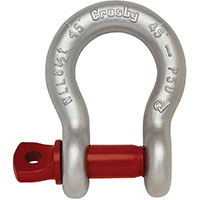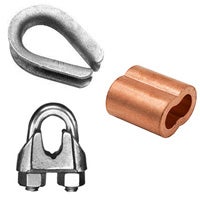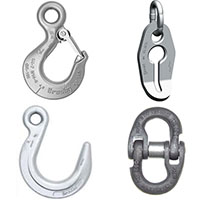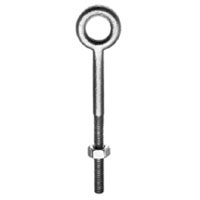Lifting & Rigging Hardware
Subcategories
-
-
Clearance - While Supplies Last!
 1/16" Type 304 Stainless Steel Malleable Type Wire Rope Clip
1/16" Type 304 Stainless Steel Malleable Type Wire Rope Clip116-304-WRCM0062
-
-
-
Clearance - While Supplies Last!
 1/4" Type 304 Stainless Screw Pin Anchor Shackle (WLL 0.50 ton)
1/4" Type 304 Stainless Screw Pin Anchor Shackle (WLL 0.50 ton)116-304-SHACKSPA0250
-
-
-
Clearance - While Supplies Last!
 5/16" Type 304 Stainless Steel Malleable Type Wire Rope Clip
5/16" Type 304 Stainless Steel Malleable Type Wire Rope Clip116-304-WRCM0312
-
-
-
Clearance - While Supplies Last!
 Forged Eye & Hook Turnbuckle 3/4" x 12" - Hot Dip Galvanized
Forged Eye & Hook Turnbuckle 3/4" x 12" - Hot Dip Galvanized115-TBEH0750X12
-
-
-
Clearance - While Supplies Last!
 Forged Eye & Hook Turnbuckle 5/8" x 9" - Hot Dip Galvanized
Forged Eye & Hook Turnbuckle 5/8" x 9" - Hot Dip Galvanized115-TBEH0625X09
-
-
-
Clearance - While Supplies Last!
 Forged Eye & Jaw Turnbuckle 1-1/4" x 12" - Hot Dip Galvanized
Forged Eye & Jaw Turnbuckle 1-1/4" x 12" - Hot Dip Galvanized115-TBEJ1250X12
-
-
-
Clearance - While Supplies Last!
 Forged Hook & Hook Turnbuckle 1/2" x 6" - Hot Dip Galvanized
Forged Hook & Hook Turnbuckle 1/2" x 6" - Hot Dip Galvanized115-TBHH0500X06
-
-
-
Clearance - While Supplies Last!
 Forged Hook & Hook Turnbuckle 5/8" x 6" - Hot Dip Galvanized
Forged Hook & Hook Turnbuckle 5/8" x 6" - Hot Dip Galvanized115-TBHH0625X06
-
-
-
Clearance - While Supplies Last!
 Forged Hook & Hook Turnbuckle 5/8" x 9" - Hot Dip Galvanized
Forged Hook & Hook Turnbuckle 5/8" x 9" - Hot Dip Galvanized115-TBHH0625X09
-
-
-
Clearance - While Supplies Last!
 Forged Jaw & Jaw Turnbuckle 1-1/4" x 24" - Hot Dip Galvanized
Forged Jaw & Jaw Turnbuckle 1-1/4" x 24" - Hot Dip Galvanized115-TBJJ1250X24
-
-
 #550 Drop Forged Alloy Rigging Snap Hook
#550 Drop Forged Alloy Rigging Snap Hook115-HK550
-
 1 Ton Alloy Eye Hoist Hook
1 Ton Alloy Eye Hoist Hook115-HKEHA01TL
Lifting and Rigging Hardware
Our Selection
We carry everything for your lifting and rigging needs. Here you can browse shackles, hooks, snaps, connection links, eye bolts, eye nuts, turnbuckles, swivels, and more. We also carry the lifting slings, wire rope, aircraft cable, chain, rigging rope, and anything else you can use with this hardware in their respective categories. Don't hesitate to call us at 877-331-3280 if you need assistance or can't find what you're looking for.
How Rigging and Lifting Hardware is Rated
When selecting rigging hardware, you must ensure that it can support your load's weight. There are obvious safety implications if you choose inadequate hardware. Each piece of hardware, from cranes and chains to shackles and slings, should be selected to minimize the risk of failure. Rigging hardware is typically rated with a working load limit (WLL) or rated capacity (RC), which may also be expressed as safe working load (SWL) or normal rated load (NRL). Manufacturers design and build equipment to support a specific WLL. Each piece of equipment's maximum working load is clearly displayed on all of our product pages. If you are unsure of the WLL, or we seem to be missing this information don't hesitate to call us at 877-331-3280.
The WLL is a calculated value that accounts for the hardware's minimum breaking strength (MBS) and a factor of safety. Minimum breaking strength is the load under which hardware can be expected to break, deform, or substantially weaken. The calculation for determining WLL is:
Working Load Limit = Minimum Breaking Strength / Factor of Safety
If the designed MBS of an eye bolt is 100 pounds and the factor of safety is 4, the working load limit is 25 pounds. For lifting equipment, the factor of safety is usually between 4 and 6, although it can be higher or lower depending on the component and circumstances. When using rigging hardware for overhead lifting, be sure not to exceed the WLL.
It should be noted that the WLL is calculated for a specific range of conditions and usage. For example, an anchor shackle's rated capacity is determined for a straight lift where the force is applied at a ninety degree angle to the shackle's pin. If the lifting force is applied at a different angle, the rated capacity is significantly lower. The rated capacity also assumes the component is installed according to the manufacturer's guidelines and used within a specified temperature range.
The Difference Between Lifting Hardware and Rigging Hardware
The terms “rigging hardware” and “lifting hardware” are often used in place of each other, but there is an important difference. While lifting hardware can be referred to as rigging, not all rigging can be used for lifting. Rigging hardware refers specifically to equipment used with rigging; the ropes, cables, and chains used to lift and suspend objects. Rigging hardware is often used to attach rigging to an object being lifted. In the case of lifting a heavy piece of equipment you might use a crane to mechanically lift the load, rigging to lift and suspend the load, and rigging hardware such as eye bolts and nuts to attach the rigging to the equipment. You must be sure the rigging hardware you are using is rated for the job you are performing.
































































